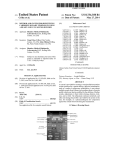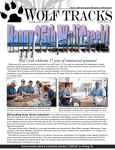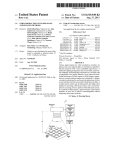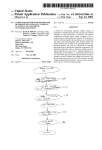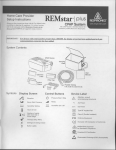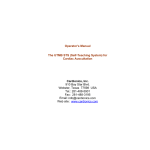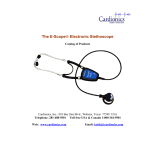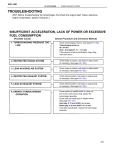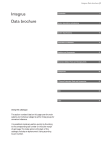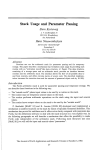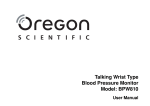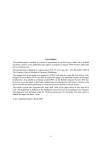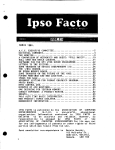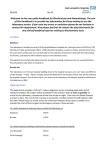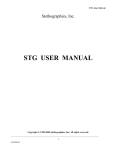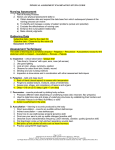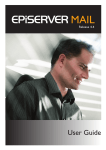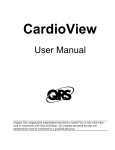Download Method and system for identifying cardiopulmonary findings by
Transcript
US008491488B1 (12) United States Patent Criley et a]. (54) METHOD AND SYSTEM FOR IDENTIFYING 7,248,923 B2 7,424,321 B2 7,438,689 B2 CARDIOPULMONARY FINDINGS BY USING A HEART AND LUNG SOUNDS BUILDER (75) Inventors: Stuart Ross Criley, Palos Verdes Estates, CA (U S); John Michael Criley, Sr., Palos Verdes Estates, CA (US) Laboratories, LLC, Rolling Hills Estates, CA (US) Notice: U.S.C. 154(b) by 0 days. (21) App1.No.: 13/252,023 (22) Filed: 7/2007 Maile et a1. 9/2008 Wariar et a1. 10/2008 Munk 4/2009 7,559,901 B2 7/2009 Maile et a1. Kushnir et a1. 7,611,471 B2 * 11/2009 7,615,012 B2 7,645,141 B2 11/2009 Von Arx et a1. 1/2010 Lecat B2 2/2010 Siejko et a1. 3/2010 Carlson et al. 6/2010 Patangay et al. 8/2010 Carlson et al. 10/2010 12/2010 2/2011 4/2011 5/2011 5/2011 6/2011 7/2011 ............. .. 600/528 Thiagarajan ................ .. 600/528 B2 B2 B2 B2 B2 B2 B2 B2 B2 7,962,210 B2 7,972,275 B2 Subject to any disclaimer, the term of this patent is extended or adjusted under 35 Jul. 23, 2013 7,517,319 B2 * 7,662,104 7,670,298 7,736,319 7,780,606 7,806,833 7,853,327 7,883,470 7,922,669 7,938,781 7,951,087 (73) Assignee: Blaufuss Medical Multimedia (*) US 8,491,488 B1 (10) Patent N0.: (45) Date of Patent: Thiagarajan et al. Patangay et al. Scheiner et al. Zhang et a1. Carlson et al. Siejko et a1. Daum et a1. Siejko et a1. (Continued) Oct. 3, 2011 OTHER PUBLICATIONS Related U.S. Application Data (60) Littman Cardiac ExamVirtual Trainer CD-ROM application manual, Provisional application No. 61/389,164, ?led on Oct. 2007. 1, 2010, provisional application No. 61/542,293, ?led (Continued) on Oct. 3, 2011. Primary Examiner * Joseph Stoklosa (51) Int. Cl. (74) Attorney, Agent, or Firm * Peters Verny, LLP (2006.01) A61B 5/02 (52) U.S. Cl. USPC (58) (57) ........................................................ .. 600/528 Field of Classi?cation Search USPC ........................................................ .. 600/528 See application ?le for complete search history. (56) References Cited ABSTRACT A system is provided for creating a sound pro?le that matches sounds produced by a patient during a physical examination, such as a cardiac or pulmonary examination. A user selects multiple sounds from a library and combines them to form the pro?le Which may then be modi?ed by the addition of further sounds, adjustments to their relative timing, duration, loud ness, and so forth. The re?nement continues iteratively, and U.S. PATENT DOCUMENTS 5,687,738 A * 11/1997 Shapiro et al. 5,957,866 A * 9/1999 6,220,866 B1 6,527,559 B2 4/2001 Amend et a1. 3/2003 Yoshii et al. 7,107,095 B2* 9/2006 after each change the pro?le is provided by the system to the .... .. 600/528 Shapiro et al. .............. .. 600/586 Manolas ..................... .. 600/513 user, for example, as a phonocardiogram for comparison against the sounds observed during the examination. 12 Claims, 6 Drawing Sheets w E66 for timing 4"“- 8611126659933)! 0? niwnaeatziisgmm Emmi button 13?)! Link 212 awnings . ' ~ 5:13am met ' £21211 m éiftamn?a Link to imp page 1 v diagnosis has? button seiezted £00; 011212111103 HSM Murmur 122mm: 80% ESM US 8,491,488 B1 Page 2 US. PATENT DOCUMENTS 8,000,780 B2 8,007,442 B2 8,012,098 B2 8/2011 Wariar et al. 8/2011 Carlson et al. 9/2011 Maile et al. 8,034,000 B2 10/2011 Zhang et al. 8,084,001 B2 8,096,954 B2 12/2011 Burns et al. 1/2012 Stahmann et al. 8,108,034 8,133,187 8,162,844 8,167,811 8,211,034 8,277,389 2004/0092846 2005/0048455 2005/0119585 B2 B2 B2 B2 B2 B2 A1 A1 A1 1/2012 3/2012 4/2012 5/2012 7/2012 10/2012 5/ 2004 3/ 2005 6/2005 Patangay et al. Holmstrom et al. Carlson et al. Scheiner et al. Patangay et al. Carlson et al. Watrous HayamiZu et al. Watrous 2008/0232605 A1 9/2008 Bagha 2009/0117527 A1 5/2009 Lecat OTHER PUBLICATIONS Adolph, R. J ., et al., “Teaching selective attention to the cardiac cycle: The Cardio-gator,” Am. Hit. 1., Aug. 1971. Cardionics CardioSim VII Sales Literature, Aug. 2008. Cardionics CardioSim VII Sales Literature, 1995. Cardionics Learning Cardiac Auscultation CD-ROM application Sales Literature, 2003. iMurmur iPhone app Product information, 2010. iMurmur iPhone app Product information, 2009. Levinson, D. “A New Audiovisual Aid to Heart-Sound Instruction,” JAMA, Sep. 1968. Easy Auscultation Website, http://WWW.easyauscultation.com/, MedEdu LLC, 2010. Pinnacle Heart Sounds Tutor Website, http://WWW.pinnacletec.com/ medical-training-products/Heart-Sounds-TUTORhtml, 1990. Cardioscan User Manual, Zargis Medical, 2009. Vukanovic -Criley, J. M., et al., “Competency in Cardiac Examination Skills in Medical Students, Trainees, Physicians, and Faculty,”Arch. Intern. Med., vol. 166, 2006. Vukanovic-Criley, J. M., et al., “Con?dential Testing of Cardiac Examination Competency in Cardiology and Noncardiology Faculty and Trainees: A Multicenter Study,” Clin. Cardiol., vol. 33, No. 12, pp. 738-45, 2010. Criley, J .M., “Beyond Heart Sounds, vol. 1” Companion Study Guide, 2000. * cited by examiner US. Patent Jul. 23, 2013 Sheet 1 of6 Audio Input Network Interface ‘— l _, v US 8,491,488 B1 User Input Device v Processor 1 > Memory Sound Library I I Audio output —> _> _ Audio Mixer _> <- DX Engine Display Output Follow on Dx GUI Questions Engine Graphics Library Explanatory Text Explanatory Graphics < Auowed Sound Combinations Matrix Sound Display _> Control Panel Sounds | DX mode Help I Settings Differential DX _> Training & “sing Engine * Tutoria| Modu|e ‘- _> Patient Findings a ‘9m F'nd'ngs Saved combinations Train/Test Scores Uplink Module —> Save Combinations 4 Module Patient Findings Power Source Test scores FIG. 1 US. Patent Jul. 23, 2013 Sheet 2 of6 US 8,491,488 B1 \\\“\ \.... US. Patent Jul. 23, 2013 g‘Eisa;?mQEu FIG. 2 Sheet 3 of6 US 8,491,488 B1 US. Patent Jul. 23, 2013 Sheet 4 of6 FIG. 3 US 8,491,488 B1 US. Patent Jul. 23, 2013 Sheet 5 of6 FIG. 4 US 8,491,488 B1 US. Patent Jul. 23, 2013 8Y%‘v B U Sp w Sheet 6 of6 US 8,491,488 B1 AO rt.m S+1. 9 n O S .m V Pulmonic Stenosis FIG. 5 w \\ US 8,491,488 B1 1 2 METHOD AND SYSTEM FOR IDENTIFYING CARDIOPULMONARY FINDINGS BY USING A HEART AND LUNG SOUNDS BUILDER that match the sounds heard from a patient during physical examination With a stethoscope, alloWing the selection of different pulseWave contours that match the arterial, venous, or precordial impulses seen on a patient during physical examination, and alloWing selection of different respiratory CROSS-REFERENCE TO RELATED APPLICATIONS patterns that match the respiration seen and heard from a patient during physical examination. This application claims the bene?t of US. Provisional Patent Application No. 61/389,164 ?led on Oct. 1, 2010 and Various embodiments of the invention are used in human and veterinary medicine as a tool to aid in identi?cation of a also entitled “Method and System for Identifying Cardiopul monary Findings by Using a Heart and Lung Sounds Builder,” and the bene?t of US. Provisional Patent Applica patient’s cardiopulmonary ?ndings. These embodiments include a computing device con?gured for selecting a com bination of sounds, murmurs, and/or lung sounds, visual examples of arterial, venous, and precordial impulses, and respiratory patterns, and combining the selected sounds and tion No. 61/542,293 ?led on Oct. 3, 2011 and entitled “Arte rial and Venous Pulsations, Precordial Impulses and Respira tory Pattern Finder,” both of Which are incorporated herein by visual examples into an audio and audiovisual sequence. The audio sequence is checked for accuracy by direct comparison reference. to sounds heard in a patient. The video sequence [animation BACKGROUND OF THE INVENTION Echocardiography Was initially developed in the mid-20th Century and its adoption in the subsequent decades has or example patient video] is checked for accuracy by direct comparison With the patient. The selection is quickly re?ned 20 selected ?ndings and patient ?ndings has been achieved. strongly in?uenced hoW clinicians are trained and hoW they These ?ndings can be documented locally on the computing device, as Well as securely uploaded to a database, and linked subsequently perform cardiac examinations of patients. A readily available, non-invasive method of imaging the beating heart that could provide critical reinforcement of What Was to the patient’s electronic health record. In some embodi 25 heard through the stethoscope should have enhanced physical examination skills, but in fact the opposite has happened. diagnoses based on a user’s selection of heart or lung sounds. Work in reverse, listing diagnoses and then playing the appro priate audiovisual ?ndings, including clinical variations that 30 are encountered across the spectrum of acute versus chronic, mild versus severe, congenital versus acquired. Finally, in some embodiments the computing device is con?gured to function in a training or testing mode, playing a patient opportunities for bedside teaching rounds. Today, hospital admissions are short and intensely focused, With feWer oppor tunities for trainees to learn and practice bedside examination ments the computing device is con?gured to list differential In some embodiments the computing device is con?gured to Cardiac examination skills have declined since the advent of echocardiography, a function of overreliance on technology and the present healthcare environment that emphasiZes rapid delivery of care. Several decades ago, patients’ hospital stays Were long, providing trainees and their instructors frequent by an iterative process until a satisfactory match betWeen ronment, further amplify the problem if their oWn cardiac recording, and prompting the user to identify correctly the heart sounds and murmurs, breath and lung sounds, pulsa tions in the neck and precordium, and respiratory patterns, grading the user entries, and storing the results locally or examination skills are not Well developed. In the absence of remotely. 35 skills Attending physicians, having been trained in this envi bedside training With patients, audio recordings of heart sounds has served as a poor substitute, and as a result clini 40 BRIEF DESCRIPTION OF DRAWINGS cians noW commonly close their eyes While conducting car diopulmonary examination, shutting out important visual and FIG. 1 is a schematic representation of a sound builder palpable cues exhibited by the patient. Multicenter studies of system according to various embodiments of the present cardiac examination skills document a rise in test scores until the third year of medical school, but no further improvement thereafter despite years in residency training, or even further 45 years in practice. (See, e.g., Arch Intern Med (166):610-617, (2006) and Clin Cardiol (33;12):738-745 (2010)) Indeed, full-time internal medicine professors perform no better in tests of cardiac examination skills than the third-year medical students they teach. Compounding the problem is a lack of created through the Sound Builder application and displayed 50 critical reinforcement When auscultating patients. Critical reinforcement implies a commitment to con?rming or refut ing one’s bedside diagnostic impressions by critical revieW and correlation With available imaging and/ or hemodynamic 55 studies performed on that patient. Unfortunately, patient With a corresponding ECG through a user interface according to various embodiments of the present invention. FIG. 3 is a schematic representation of common listening locations for stethoscopic cardiac examination. FIG. 4 is a graphical representation of an alert provided by the Sound Builder application and displayed through a user interface according to various embodiments of the present invention. FIG. 5 is a graphical representation of a differential diag exposure Without critical reinforcement seems to be the norm for the average medical resident, explaining their lack of advancement in examination skills despite clinical encoun ters With hundreds of patients. invention. FIG. 1.5 is a graphical representation of a control panel provided through a user interface according to various embodiments of the present invention. FIG. 2 is a graphical representation of a phonocardiogram nosis screen provided by the Sound Builder application and 60 displayed through a user interface according to various embodiments of the present invention. SUMMARY DETAILED DESCRIPTION This invention relates to audiovisual display on a digital computer system, inpar‘ticular, visual as Well as audio display of cardiac and lung auscultation, alloWing the selection of individual sound components to create custom combinations 65 FIG. 1 illustrates the general architecture of the sound builder system as embodied in an electronic computing device con?gured to execute a Sound Builder application. In US 8,491,488 B1 3 4 some embodiments the electronic computing device includes is added to the playback, the visual display of the phonocar diogram shows the new component in its proper temporal a cellular telephone, digital pad, personal digital assistant, personal computer, and/or the like. Audio input is received location, and the selected button lights up to show the user which components are already active. from an external source: from a wired audio connection to a microphone and/or stethoscope; from a wireless connection The Sound Builder application is con?gured to generate via the Network Interface (e. g., WiFi, Bluetooth, USB); and/ the control panel which provides the user with menus such as or from a live transmission or recorded transmission of a a component-based menu and a lesion-based menu. The com patient recording. ponent-based menu allows the user to select sounds, mur User input is received via a user input device. The user input device uses the user input to select sound components, to create a combination. The lesion-based menu allows the murs, and murmur combinations (e.g., to-fro murmurs) used switch to text, help, settings, or diagnosis sections (Dx) of the user to select a lesion and optionally to further modify the lesion. Selected lesions can be acute or chronic and vary from mild to severe. The control panel can also be con?gured to allow the user to vary or specify the heart rate and the listening location. In various embodiments some or all of the features below can be selected and/or controlled. A ?rst heart sound (S1) is Sound Builder application, to submit answers to training/test questions, to record patient ?ndings, or to control the volume, temporal location, tempo of the sound combinations, and/or the like. In some embodiments, selected sound combinations are checked against an Allowed Combinations Matrix before playing. Combinations may be saved for later recall. Patient ?ndings may be saved and/or uploaded via the Network Inter face. In some embodiments, sound components are recalled from Memory and sent to the Audio Mixer before being sent selected, for instance, by recording the location on the patient at which the sound is heard, as the location will in?uence the 20 of different types, such as single and split (e. g., physiological, to Audio Output. The Display Output is updated to re?ect the paradoxical, or persistent), loudness can vary from absent to soft to loud, and their timings can be adjusted from early new sound combination chosen by the user. The following is a step-by-step description of how various embodiments of the invention may be used. The computing sound. Sound components, their loudness, and their relative timings can also be selected for S 1. Sound components can be 25 through the expecting timing to late. Second (S2), third (S3), and fourth (S4) sounds are simi device of the invention can be con?gured to perform some or larly selected. In some embodiments, the quality of S3 can be all of these steps. The various alternatives provided are not meant to be limiting. Other alternatives are considered to be within the scope of the invention. A user listens to a patient’s heart sounds, for example, ness can be varied from soft to medium to loud. The loudness of S4 can also be varied from soft to medium to loud and the selected, such as dull, rumbling, and knocking, and the loud 30 through an acoustic stethoscope, through an electronic stethoscope, from a received live transmission via computer network, from a recorded transmission via computer net work, from a locally stored recording, or from a remotely stored recording. Transmission methods to reach the user’s 35 ear include, for example, (1) via headset (wired or wireless) attached or paired to an electronic stethoscope, (2) via head phones (wired or wireless) attached or paired to an electronic stethoscope, (3) via a wired or wireless speaker placed under valsihigher left atrial/ left ventricular pressure gradient, 40 transmitting stethoscope or system. shifted relative to the timing of other sounds such that, for The user launches the Sound Builder application on the instance, the S l -MSC interval can vary, with shorter intervals 45 a computer readable medium and executed by a processor of the computing device. The Sound Builder application option ally comprises a smartphone application, a website-based program, an application installed on a personal computer, an implying more severe mitral stenosis; and longer intervalsi lower left atrial/left ventricular gradient, implying less severe mitral stenosis. The MSC can be selected for the mitral valve or the tricuspid valve. The MSC timing can likewise be or attached to an acoustic or electronic stethoscope, and (4) via external audio input and/ or electronic interface with the computing device. The Sound Builder application can be implemented in hardware, ?rmware and/or software store on location (left or right ventricular) can be recorded. Other selectable sounds can include an opening snap (OS), an ejection sound (ES) which can be aortic or pulmonic, and a mild systolic click (MSC). The OS loudness can vary from soft to loud, and the OS timing can be shifted relative to the timing of other sounds. For example, the S2-OS interval can vary either continuously or in discrete steps; shorter inter 50 application installed on a personal digital assistant, an embed ded application of an electronic stethoscope. implying an earlier systolic prolapse, and longer intervals implying a later systolic prolapse. The MSC can be given an accompanying murmur. For example, mitral or tricuspid regurgitation may occur with prolapse, causing a murmur that immediately follows the click. The timing of this murmur depends upon the timing of the click, such that the murmur can be holosystolic, midsystolic, or late systolic. Other selectable sounds comprise murmurs such as dias tolic murmurs, systolic murmurs, and continuous and to-fro The user selects a sound-murmur combination, for example, by pressing inputs (e.g., on-screen buttons). The murmurs. Selectable diastolic murmurs include early dias nents and mixes the audio tracks dynamically to create a tolic, mid diastolic, and presystolic murmurs, and as above, for each the location on the patient is speci?ed. For early repeating heart and/or breath sounds. This audio playback diastolic murmurs, quality (harsh or high-pitched), shape (de optionally continues uninterrupted until a further sound, mur crescendo or crescendo-decrescendo), and duration (long and tapering or short and abruptly terminated) can be selected. sound builder takes the one or more selected audio compo 55 mur, or breath sound is added or removed, or until the user halts the playback. FIG. 1.5 shows an exemplary control panel provided by the Sound Builder application executing on an electronic com puting device. In some embodiments, the user starts with a blank slate, or more speci?cally, a simple S1 S2 combination. By adding sounds or murmurs, a combination of sounds is built up to match what is heard in the patient. Each time a button is selected on the control panel, the sound component 60 For mid diastolic murmurs quality and loudness can be selected, and for presystolic murmurs shape (crescendo), loudness, and accompanying sounds and murmur can be selected. Accompanying sounds and murmur can comprise a mid diastolic murmur, an OS, and a loud Sl. 65 Selectable systolic murmurs include holosystolic, early systolic, mid systolic, and late systolic murmurs, and as above, for each the location on the patient is speci?ed. For US 8,491,488 B1 5 6 each, too, the quality is selectable (harsh, blowing, or musi cal). The holosystolic shape can be equal intensity, cre scendo-decrescendo, or decrescendo. The early systolic and late systolic shapes can be decrescendo, While the mid sys ness and quality of heart sounds and murmurs, and some sounds and murmurs are only detectable in speci?c locations on the patient’s chest, and only With either the stethoscope bell or diaphragm. Also, the quality of the same murmur can be harsh or musical depending upon the location of the stetho scope. The location of the stethoscope can be indicated on the screen by text and/or by an indicator on a chest diagram. SWitching to a different location Will cause the selected sound tolic shape can be equal intensity or crescendo-decrescendo. The duration of the late systolic murmur is also variable. For continuous murmurs location on the patient is speci ?ed. Timing is also controllable as the peak of murmur inten sity varies depending upon the etiology. To-fro murmurs comprise semilunar and atrio -ventricular murmurs, both have systolic and diastolic components, and for both the location combination to update. For example, moving from the cardiac apex (5th left intercostal at the midclavicular line) to the 2nd right intercostal space Will cause S3 or S4 to disappear, and on the patient is speci?ed. Semilunar to-fro murmurs can be aortic or pulmonic, and either can be characterized as to-FRO moving from the cardiac apex (5th left intercostal at the midclavicular line) to the 2nd left intercostal space Will cause MDM and PSM to disappear. The Sound Builder application can provide the user With an option of focusing on similar heart sounds and murmurs (louder diastolic component) or TO-fro (louder systolic com ponent). Aortic to-fro murmurs can also be Austin Flint mur murs, While pulmonic to-fro murmurs can be right-sidedAus tin Flint murmurs. Atrio-ventricular to-fro murmurs can be mitral or tricuspid. FIG. 2 illustrates a sound sequence assembled from sound 20 (cardiac base), and S1 S2 S3 (cardiac apex). Extra sounds components, according to various embodiments of the inven tion. The sound sequence displayed shoWs the ECG, phono cardiogram, and the phases of the cardiac cycle, systole and diastole. Control buttons sWitch the display to settings, help, explanatory text, and the relevant differential diagnoses for near Sl include Sl ES S2 (cardiac apex or sometimes base), Split S1 S2 (cardiac apex), and S4 S1 S2 (cardiac apex). The Sound Builder application is optionally con?gured to 25 the rate may increase, but the sounds and murmurs them account for one or more of the folloWing maneuvers and perturbations. The sound sequence can be varied depending this sound combination. Slider controls alloW the user to vary the heart rate and the playback volume. In some embodiments the Sound Builder application is con?gured to alloW user control of heart rate, rhythm, and regularity. Heart rate can be varied to re?ect different patient conditions, such as sloWer heart rates for relatively longer diastoles and faster heart rates for relatively shorter diastoles. Heart sounds and murmurs can be affected by changes in rhythm, for example, cannon Wave, post-extrasystolic beat augments/does not augment murmurs, and atrial ?brillation (long or short diastoles). The frequency of the sound or mur mur is not generally affected by the heart rate; for this reason, combinations While changing the location. For instance, extra sounds near S2 include S1 S2 OS (cardiac base), Sl Split S2 on user-selectable factors such as respiration, posture, extra 30 systolic beat, hand grip, and Valsalva maneuver. Options for respiration include apnea, inspiration, and expiration, the lat ter tWo of Which can augment murmurs, augment sounds, and split sounds. Posture options include supine, left lateral decu bitus, sitting upright, sitting While leaning forWard, standing, squatting, and passive leg elevation. The extrasystolic beat 35 can augment or not augment the murmur. Hand grip options include control, grip, and release, While options for the Val salva maneuver include control, strain, release, and recovery. 40 FIG. 4 illustrates an alert provided to the user through the Sound Builder interface When an implausible combination is selected, as not all combinations of heart sounds and murmurs selves must be changed in temporal location (and often dura are physiologically possible. An exemplary implausible com tion) Without altering the frequency spectrum. Using discrete bination is an opening snap (OS) and a third heart sound (S3). sound components alloWs the heart rate to be varied up or doWn Without adversely affecting the frequency of the play These sounds are not likely to occur simultaneously in a 45 back. FIG. 3 illustrates a chest diagram With circles indicating four common listening locations for a stethoscope during mitral valve, While a third heart sound usually requires a Wide open mitral valve. In various embodiments a caution triangle appears in the sound display, and the user is alerted With a notice. cardiac examination (other listening positions are possible). The numbers indicate intercostal spaces. Locations are gen erally noted as left or right, and by intercostal space. In the Sound Builder application, the location of the current heart sounds recording can be noted by this chest diagram, as Well as alternate listening areas. For breath and lung sounds, a 50 55 user selects combinations that are speci?cally heard at one or tWo locations, the sound builder updates the displayed loca 60 As noted, the location of the stethoscope chest piece, and shoWn beloW in Table 1. Adding more than one example of each murmur or sound Will increase the combinations, but more importantly, increase the verisimilitude of the combi nations. For example, the ?rst heart sound of mitral stenosis is louder than normal; thus, a loud ?rst heart sound of mitral sound/murmur combination to change What Would be expected to be heard in a patientiin many cases removing the choice of stethoscope bell or diaphragm, affects the loud combinations, a sounds and murmurs matrix includes 75,344 valid combinations. The Sound Builder application can auto matically screen implausible selections by consulting a Sound-Murmur Plausibility Matrix, an example of Which is similar diagram is used. The user can change to a neW listen the extra sound or murmur altogether. It is noted that With 20 heart sound and murmur compo nents, there are an excessive number of possible combina tions, but by limiting the combinations to only alloWable ing position by selecting a different circle. In addition, if the tion to shoW Where these sounds and murmurs Would be heard. Manually sWitching to a neW location Will cause the patient since the opening snap requires a narroWed, stenotic 65 stenosis Would be substituted for a normal ?rst heart sound. As another example, the midsystolic murmur of aortic steno sis can sound harsh When listening at the cardiac base, but musical at the cardiac apex. US 8,491,488 B1 TABLE 1 Allowed TFM “l” is a valid combination; “0” is an invalid combination right), femoral (left or right), popliteal (left or right), and post The user can look at and listen to (as well as palpate) the created combination. The Sound Builder application seam 40 tibial (left or right). Contour can include normal, quick, ?ick lessly loops the audio of the created combination, and the user ing upstroke, bounding, collapsing, slow rising, or distorted, may choose to listen via headphones, a wireless headset, an electronic stethoscope, or a wired or wireless speaker attached to an acoustic stethoscope, for example. While a when palpating pulse at peripheral vessels. These pulse con loudspeaker can be used, it is noted that loudspeakers can distort audio. tours can be displayed as waveforms or as audiovisual ani 45 (systolic rise occurs close in time with ventricular systole) or distal to the heart (systolic rise is delayed, and the pulse contour is distorted). The user can also observe the ECG waveform and the phonocardiogram, and also the selected buttons on the pro vided intcrfacc. Thc ECG wavcform can indicate, for example, the onset of systole. The ECG waveform may morph, consistent with the sound-murmur combination selected. The phonocardiogram provides a visual depiction of Thc uscr can compare the combination to thc paticnt’s 50 heart sounds. Two methods for making the comparison involve either switching ear pieces or not switching ear 55 (no confusing artifacts), and to enhance recognition at small resolutions. The combination selected can be indicated, in some embodiments, by labeled buttons in an ON state (e.g., a white-colored button). The last button selected is optionally highlighted a different color (e.g., a yellow-colored button). pieces. Where switching ear pieces is employed, the Sound Builder application plays the selected audio combination and a stethoscope or playback device plays the patient’s heart sounds on a separate system. Alternatively, the Sound Builder application can be switched between playing the selected 60 audio combination through a set of ear pieces and either a live transmission or a recording of the patient’s heart sounds. In another alternative, the Sound Builder system includes an external speaker, and the user moves the stethoscope between the patient’s chest and the external speaker to make the com 65 parison. As noted, the user can palpate the created combination. In some embodiments, a signal to drive a palpable pulse will accompany the audio. Some embodiments provide a stereo output where one channel contains the audio and the other channel contains the pulse signal, including modulation and DC voltage. Locations include carotid (left or right), apical (apex beat), parastemal, brachial (left or right), radial (left or heart sounds. For instance, by switching back and forth to the patient’s heart sounds, the user can check whether the selected combination is a reasonable match to the patient’s heart sounds and murmurs and can be selected to show the selected combination, the actual heart sounds and murmurs of the patient, as well as cartoon depictions of idealized forms mations of the neck and precordium. Intensity and timing are additional options, where timing can be proximal to the heart A good match with the patient will not require further modi?cation of the combination. A poor match will prompt US 8,491,488 B1 9 10 the user to modify his selected combination. Errors in under standing the de?nitions can lead to erroneous selections, for Which are often considered different in origin from harsh murmurs, When in fact they have the same etiology. example, the user may confuse a continuous murmur With a Diastolic murmurs that are often confused include EDM to-fro murmur. Failure to identify systole can also lead to erroneous selections, for instance, the user may confuse a vs. MDM, EDM long vs. CM, and EDM With MDM (Austin systolic murmur With a diastolic murmur. confused include Sl MSC LSM S2, S1 ES MSM S2, and S4 S1 HSM S2. The best match result of this re?nement process may be de?nitive or may contain ambiguous features. In the latter instance, for example, the user may not be able to determine Flint) vs. EDM. Sound/murmur combinations that are often In various embodiments the Sound Builder application provides an info section that the user can access by pressing the info button, for instance, in order to learn more about each sound/murmur choice. The ?rst page displayed in the info Whether an extra sound near S1 is S4-Sl, Sl-ES, or a split Sl. section can be linked to the last button the user selected on the Over-speci?city may not be appropriate When the ?ndings cannot be ?rmly established, and alternative ?ndings can be stored With equal Weight, or With preferential Weights assigned to the alternatives. control panel. Additional pages that describe other control panel choices can be made available from a table of contents, or by pressing previous or next buttons. Similarly, various embodiments the Sound Builder appli cation provide a help section that can be accessed, for example, by pressing the help button to display the help section on the screen. The help section can provide a descrip tion each button’s appearance and function, program How, a 20 description of each section, the role of the differential diag nosis section (including limitations and When alternative diagnoses should be considered), recommended customiZed settings based on the user’s preferences, and cardiac exami nation tips and tricks to improve detection and identi?cation example, Sl ES MSM S2 has a short list of potential diag noses, either bicuspid aortic stenosis or aortic stenosis. The Sound Builder application can help narroW the choices fur ther With queries to the user. For example, the user can be 25 of ?ndings. Various embodiments the Sound Builder application can also provide the user the ability to customiZe certain settings. Examples of customiZable settings include the display, Wam ings, and preferences for sending and receiving data. asked to report the contour of the carotid pulse (for aortic stenosis the pulse is parvus et tardus), to compare 2nd right vs. 2nd left intercostal listening areas, or the user can be prompted to learn more about the clinical setting by suggest ing intervieW questions for the patient. 30 The Sound Builder application can also provide the user the ability to modify a combination to create a closer match to the patient’ s sounds, for example, through an interactive pro cess, possibly over several iterations, of selecting a combina tion, comparing the combination to the patient, and modify FIG. 5 illustrates a differential diagnosis list that can be provided to the user as a list of potential differential diagnoses based on the ?nal combination entered. The Dx button turns green, in some embodiments, to indicate that the list of poten tial diagnoses has become very narroW. In the illustrated The Sound Builder application may create the Dx list by consulting a Sounds-Murmurs Dx Matrix that contains likely diagnoses mapped to the selected sounds and murmurs. This list of differential diagnoses can be dynamically updated based upon further input from the user, including listening 35 location, patient history, and vital signs (e.g., pulse contour, heart rate, body temperature, blood pres sure). Patient history can comprise the patient’s chief complaint, social history (e.g., smoking, IV drug abuse), any childhood illness, and country of origin (e.g., Where rheumatic fever is still preva ing the combination, to hone in on a best match to the patient ?ndings. The Sound Builder application can also offer plausible alternatives to aid in the step of modifying the combination. For instance, sound combinations near S1 and S2 are often 40 lent). The Dx list can be sorted by plausibility, or severity, and confused, heart sounds are often not heard When a murmur is each Dx entry can be linked to explanatory text, illustrations, and audio or audiovisual examples of patient recordings. present, systolic murmurs are often confused, diastolic mur The Sound Builder application, in some embodiments, suggests additional actions to narroW the differential diagno murs are often confused, continuous murmurs are often con fused With to-fro murmurs, certain sound/murmur combina tions are commonly confused, and confusion of systole and 45 Regarding sound combinations near Sl, the combinations ofS4 and S1, split and S1, S1 and ES, S1 and early MSC are commonly confused. Regarding sound combinations near S2, the combinations of late MSC and S2, split and S2, S2 and OS, and S2 and S3 are commonly confused. Heart sounds that sis, including altering the listening location, sWitching from stethoscope bell to diaphragm, postural maneuvers, and the postextrasystolic beat. Altering the listening location can diastole leads to a large number of errors. help, for example, to differentiate betWeen Whether an extra 50 heart sound near S1 is an S4, a split S1, or an ejection sound. If the extra sound is heard at locations in addition to the cardiac apex, it is likely to be an ejection sound, With a softer Sl preceding it. LikeWise, listening at the apex With the stethoscope bell Will most likely detect the loW-frequency S4, are often not heard When a murmur is present include S1 and S2 With HSM, S3 With HSM or another murmur, and MDIVI/ but sWitching to the stethoscope diaphragm (Which ?lters loW S3 rumble With EDM (Austin Flint). HSM. Here, right-sided murmurs may in fact be midsystolic, frequency sounds) should make the extra sound go aWay. Postural maneuvers can help detect the midsystolic click of but run into or past the aortic valve closure sound (usually the mitral valve prolapse Which can occur earlier or later as a loudest component of S2) tricking the user into thinking the murmur is holosystolic. An ejection sound (ES) may precede the MSM, tricking the user into thinking the murmur begins function of standing and squatting and as a function of the Valsalva maneuver. The postextrasystolic beat (the beat that Systolic murmurs that are often confused include MSM vs. 55 60 with S1, and concluding the murmur is ESM or HSM. Cre scendo-decrescendo holosystolic murmurs are possible, and may confuse the user Who expects this shape of murmur to be exclusively midsystolic. Other systolic murmurs that are often confused include MSM vs. ESM (both end before S2), LSM vs. MSM vs. HSM (regurgitation folloWing the click of mitral valve prolapse), and musical murmurs (Gallavardin) 65 folloWs a preventricular contraction, or PVC) can narroW the origin of a systolic murmur. Systolic murmurs that augment folloWing a PVC are generally con?ned to the ventricular out?oW tract such as aortic stenosis and hypertrophic cardi omyopathy, While systolic murmurs that do not augment include the holosystolic murmur of mitral regurgitation. The Sound Builder application, in some embodiments, suggests items in the patient’ s history or the clinical setting to US 8,491,488 B1 11 12 investigate to narrow further the differential diagnosis. As both ears give the brain cues as to the location of a particular sound. These audio cues can be added to existing audio With examples, a patient presenting With Worsening dyspnea dur ing pregnancy suggests mitral stenosis, While being from head-related transfer functions (or similar methods) to create the perception that a particular sound is emitting from a certain areas of the World (e.g., the Paci?c Rim and Latin America) can implicate rheumatic fever. As another example, certain position in space. For example, positioning the audio aortic regurgitation secondary to endocarditis can be due to location of S1 and S2 behind the user’ s head, and positioning the murmurs in front, can help the user identify the sounds, and differentiate them from the murmurs. Likewise, the pres ence of an extra heart sound can be highlighted by placing the IV drug abuse With infected needles. As yet another example, a third heart sound can be physiologic or pathologic in origin, Where a physiologic third heart sound is common in athletes, the healthy young, and pregnancy, While a pathologic third heart sound can be due to ventricular dysfunction secondary extra sound in yet another position (e.g., left or right). Merg ing the sounds and murmurs back into monoaural space Will re?ect What is heard through the stethoscope, While expand ing the sounds to highlight components aids in their identi? to myocardial infarction, hypertension, or dilated cardiomy opathy. cation. Another aid in identi?cation is matching visual infor mation (either video of patient or computer animation of an The Sound Builder application can assist the user to docu ment the patient’ s cardiac examination ?ndings by appending the patient name, ID number, location (of the patient), time and date to the ?ndings, and by adding the patient’s history, vital signs, and other patient data. Listening location can be added by selecting a listening area off of a chest diagram. The examination ?ndings can indicate that the ?nal selection sat is?ed the user that these are the ?ndings established upon examination of the patient, or may indicate that the ?nal selection contains appropriate ambiguity Where a ?nding can not be ?rmly established. Documented ?ndings can be uploaded securely With encryption to a database that stores the patient’s electronic health record. In some instances, the Sound Builder application can be avatar) to the sounds, to aid in recognition. Human hearing becomes more sensitive and speci?c if a sound is accompa nied by a visual cue. Animation or video of pulsations in the neck or precordium, or movement of the chest during respi 20 Will aid the user in identifying individual sound components. The Sound Builder application can also comprise a lung sounds builder module that functions analogously and With the same technology as the heart sounds builder module illus 25 nents in order to create a matching combination. The user can panel. Here, the user starts With a diagnosis, and the Sound While selecting calci?c aortic stenosis Will cause the applica tion to produce the pattern of S l, MSM, S2. Similarly, select ing Well-tolerated chronic aortic regurgitation Will cause the 30 the selected combination With the patient’s lung sounds and modi?es the selected combination as necessary to improve 35 lung sounds builder suggests additional listening locations, 40 lung sounds that are associated With the selected patient con dition. examples. Mitral stenosis may be tolerated by the patient at a 45 indicated by an opening snap and a barely detectable mid diastolic murmur. The more severe mitral stenosis is indicated by loud Sl, MDM, perhaps no PSM, and longer S2-OS inter 50 ured to facilitate methods to improve identi?cation of indi vidual sound components. As one example, by adding and ments and applications beyond those described herein Without departing from the broader spirit and scope of the speci?cation. The speci?cation and draWings are, accord ingly, to be regarded as illustrative rather than restrictive. As used herein, logic refers to hardWare, ?rmWare, or a combi 55 murs. With S1 S2 S3, often the user does not perceive the loW-frequency, loW-intensity S3, thus, by adding and remov nation of hardWare and softWare such as a processor and computer readable instructions stored on a computer readable medium, but logic as used herein speci?cally excludes soft Ware alone. It Will be recogniZed that the terms “comprising,” “including,” and “having,” as used herein, are speci?cally ing S3 While S1 and S2 remain can improve detection by giving the user a visual cue When S3 is present on the phono cardiogram, as Well as by playing the extra sound. As another In the foregoing speci?cation, the invention is described With reference to speci?c embodiments thereof, but those skilled in the art Will recogniZe that the invention is not limited thereto. Various features and aspects of the above described invention may be used individually or jointly. Fur ther, the invention can be utiliZed in any number of environ val. The very severe mitral stenosis is indicated by a louder removing a single component to highlight its presence or absence against the background of other sounds and mur maneuvers, and items in the patient’s history or clinical set ting to narroW further the differential diagnosis. In various embodiments, the lung sounds builder can be used in reverse: starting With a condition, and playing back the spectrum of Mitral stenosis and regurgitation provide additional and later Sl, PSM, MDM, and short S2-OS interval. The Sound Builder application optionally may be con?g the match to the patient’s lung sounds. The lung sounds builder is con?gured to suggest differential diagnoses based on the combination selected. In various embodiments, the regurgitation, MDM at the apex. sloW heart rate, become more severe With moderate heart rate, or very severe With fast heart rate. Tolerated mitral stenosis is also select different patient postures (e.g., supine, upright), respiratory patterns (normal, tachypnea, Cheyne-Stokes), or patient maneuvers (e. g., egophony). The user then compares application to produce long EDM, selecting acute severe aortic regurgitation Will produce short EDM, MSM, Sl (soft or absent), and selecting Austin Flint aortic regurgitation Will produce, in addition to the sounds of acute severe aortic trated above, but employing breath sounds components. Here, the user listens to the patient’ s chest for lung sounds and consults the lung sounds builder to select lung sound compo used in reverse by using a lesion-based menu on the control Builder application then reproduces the spectrum of ?ndings associated With that lesion for comparison against the patient. For instance, selecting congenital aortic stenosis Will cause the application to produce the pattern of S1, ES, MSM, S2, ration, When displayed in time With the heart and lung sounds, 60 intended to be read as open-ended terms of art. example, positional audio processing can be employed to What is claimed is: place components in three-dimensional space, so that the user can perceive some sounds as occurring in front, to the side, or behind the ears. Human hearing is very sensitive to positional 1. A method comprising: selecting, using an input device of a computing system, a cues that occur as sounds are modi?ed as they re?ect off 65 external surfaces, as Well as the portions of the external ear. In components; selecting, using the input device, a second bodily sound addition, subtle differences in frequency and arrival time to component from the menu of sound components, the ?rst bodily sound component from a menu of sound US 8,491,488 B1 14 13 ?rst and second bodily sound components being repre sentative of ?rst and second sounds of a stethoscopic 7. The method of claim 1 further comprising an act of reading a list, the list including the names of differential examination; diagnoses, the list being read from the display of the comput observing on a display of the computing system, and lis ing system. tening to, a repeating graphical representation of the ?rst 8. The method of claim 4 further comprising vieWing on the display of the computing system an ECG proximate to the graphical representation of the ?rst and second sound com and second sound components; and simulating an abnormality by iteratively modifying and observing the graphical representation. ponents. 2. The method of claim 1 Wherein the ?rst bodily sound component is a ?rst lung sound component and Wherein the second bodily sound component is a second lung sound com 9. The method of claim 1 Wherein listening to the repeating graphical representation of the ?rst and second sound com ponents includes hearing the ?rst and second sound compo nents spatially separated from one another. 10. The method of claim 4 Wherein the ?rst and second ponent. 3. The method of claim 2 Wherein selecting the ?rst and second bodily sound components from the menu of sound sounds are heart sounds S1 and S2. components comprises selecting a respiratory pattern from a menu of respiratory patterns. 4. The method of claim 1 Wherein the graphical represen tation of the ?rst and second sound components comprises a 11. The method of claim 1 further comprising physically examining a patient, Wherein the ?rst and second sound com ponents are selected to be representative of ?rst and second sounds heard during a stethoscopic examination of the phonocardiogram. 5. The method of claim 1 Wherein modifying the graphical representation comprises selecting a third sound. 6. The method of claim 1 Wherein modifying the graphical representation comprises changing a relative timing of the ?rst and second sounds. 20 patient. 12. The method of claim 11 further comprising uploading, from the computing system, ?ndings from the physical examination to an electronic health record for the patient. * * * * *















